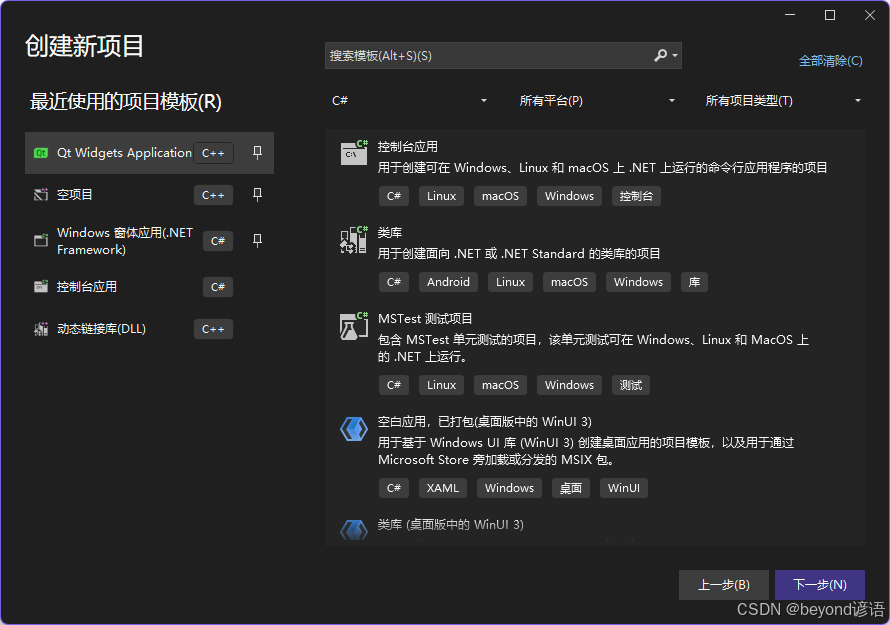一、大纲
学习内容:使用两个线程,分别点击两个按钮,触发两个不同的效果
所需控件:两个button、三个label
涉及知识点:多线程、Qt的connect机制、定时器、互斥锁
需求:
1,多线程定时计数:创建两个独立的线程,每个线程中运行一个定时器,定时器分别以不同的时间间隔触发,每次触发时更新界面上的标签,显示该线程定时器的调用次数。
2,按钮点击计数:界面上有两个按钮,每个按钮被点击时,更新相应的标签,显示该按钮的点击次数。
在工作中涉及到采用多线程读取PLC同一块内存,将核心思路进行了总结,并抽离了一下,用比较简单的demo进行演示,故此作为笔记,后续有利于复习
二、应用场景
1,工业自动化领域
通过多线程读取PLC的同一个DB块的内存数据
2,游戏开发领域
多线程定时计数功能可以实现游戏中的倒计时功能,比如限时任务的剩余时间、技能冷却时间等。
3,智能家居领域
多线程定时计数功能可以定时收集设备的能耗数据,通过统计一段时间内的能耗变化,分析设备的使用习惯和能耗规律。
三、创建Qt项目





目录结构

四、UI布局
在wdiget里面有俩button和三个label

五、代码
1,main.cpp
#include "qt_thread.h"
#include <QtWidgets/QApplication>
#include <QTextCodec>
int main(int argc, char *argv[])
{
QApplication a(argc, argv);
beyondyanyu_study_qt_thread::QtThread w;
w.show();
return a.exec();
}
2,qt_thread.h
#pragma once
#include <QtWidgets/QMainWindow>
#include <QMutex>
#include "ui_QtThread.h"
namespace beyondyanyu_study_qt_thread {
class QtThread : public QMainWindow
{
Q_OBJECT
public:
QtThread(QWidget* parent = nullptr);
~QtThread();
private slots:
void PushButton1_clicked();
void PushButton2_clicked();
private:
Ui::QtThreadClass ui;
QThread* thread_1_;
QThread* thread_2_;
QTimer* timer_label_1_;
QTimer* timer_label_2_;
int counter_1_{0};
int counter_2_{0};
int counter_3_{0};
int counter_4_{0};
QMutex mutex_{ QMutex::Recursive };
};
};// namespace beyondyanyu_study_qt_thread
成员变量
Ui::QtThreadClass ui;:这是用于存储 UI 界面元素的对象,一般由 Qt 的 UI 设计器生成。借助 ui 能访问并操作界面上的各类控件,例如按钮、标签等。
QThread* thread_1_; 和 QThread* thread_2_;:这两个指针分别指向两个不同的 QThread 对象,用来创建和管理两个独立的线程。每个线程都可并行执行任务,互不干扰。
QTimer* timer_label_1_; 和 QTimer* timer_label_2_;:这两个指针分别指向两个 QTimer 对象,用于定时触发特定操作。timer_label_1_ 和timer_label_2_能以不同的时间间隔触发超时信号。
int counter_1_{0};、int counter_2_{0};、int counter_3_{0}; 和 int counter_4_{0};:这些整型变量作为计数器使用。counter_1_ 和 counter_2_ 分别记录 timer_label_1_ 和 timer_label_2_ 定时器的超时次数;counter_3_ 和 counter_4_ 分别记录 ui.pushButton 和 ui.pushButton_2 按钮的点击次数。
QMutex mutex_{ QMutex::Recursive };:这是一个递归互斥锁对象,用于保证多线程环境下对共享资源(如 counter_1_ 和 counter_2_)的安全访问,防止数据竞争问题。
成员函数
QtThread(QWidget* parent = nullptr);:这是 QtThread 类的构造函数,用于初始化 QtThread 对象。在构造函数里会进行界面的初始化、线程的启动、定时器的设置以及信号与槽的连接等操作。
~QtThread();:这是 QtThread 类的析构函数,负责在对象销毁时释放相关资源,不过当前代码里该析构函数为空。
void PushButton1_clicked(); 和 void PushButton2_clicked();:这两个函数属于槽函数,会在 ui.pushButton 和 ui.pushButton_2 按钮被点击时分别触发,用于更新相应的计数器并修改界面上的标签显示。
3,qt_thread.cpp
#include "qt_thread.h"
#include <QThread>
#include <QTimer>
namespace beyondyanyu_study_qt_thread {
QtThread::QtThread(QWidget* parent)
: QMainWindow(parent)
{
ui.setupUi(this);
//按钮一
//开启线程
thread_1_ = new QThread();
thread_1_->start();
//开启一个定时器
timer_label_1_ = new QTimer(this);
timer_label_1_->setInterval(1000);
timer_label_1_->start();
//将改定时器移动到线程中
timer_label_1_->moveToThread(thread_1_);
connect(timer_label_1_, &QTimer::timeout, timer_label_1_, [this]
{
QMutexLocker locker(&mutex_);
counter_1_++;
ui.label_3->setText(QStringLiteral("线程1调用次数:") + QString::number(counter_1_));
});
//按钮二
//开启线程
thread_2_ = new QThread();
thread_2_->start();
//开启一个定时器
timer_label_2_ = new QTimer(this);
timer_label_2_->setInterval(900);
timer_label_2_->start();
//将改定时器移动到线程中
timer_label_2_->moveToThread(thread_2_);
connect(timer_label_2_, &QTimer::timeout, timer_label_2_, [this]
{
QMutexLocker locker(&mutex_);
counter_2_++;
ui.label_3->setText(QStringLiteral("线程2调用次数:") + QString::number(counter_2_));
});
connect(ui.pushButton, &QPushButton::clicked, this, &QtThread::PushButton1_clicked);
connect(ui.pushButton_2, &QPushButton::clicked, this, &QtThread::PushButton2_clicked);
}
void QtThread::PushButton1_clicked()
{
counter_3_++;
ui.label->setText(QStringLiteral("按钮1触发次数:") + QString::number(counter_3_));
}
void QtThread::PushButton2_clicked()
{
counter_4_++;
ui.label_2->setText(QStringLiteral("按钮2触发次数:") + QString::number(counter_4_));
}
QtThread::~QtThread()
{
// 停止线程
thread_1_->quit();
thread_1_->wait();
delete thread_1_;
thread_2_->quit();
thread_2_->wait();
delete thread_2_;
// 删除定时器
delete timer_label_1_;
delete timer_label_2_;
}
} // namespace beyondyanyu_study_qt_thread;
构造函数 QtThread::QtThread(QWidget* parent)
ui.setupUi(this);:初始化 UI 界面,把 UI 设计器设计的界面元素加载到 QtThread 窗口中。
按钮一相关操作:
thread_1_ = new QThread(); 和 thread_1_->start();:创建并启动一个新线程 thread_1_。
timer_label_1_ = new QTimer(this);、timer_label_1_->setInterval(1000); 和 timer_label_1_->start();:创建一个定时器 timer_label_1_,设置其时间间隔为 1000 毫秒(即 1 秒),然后启动该定时器。
timer_label_1_->moveToThread(thread_1_);:将 timer_label_1_ 定时器移动到 thread_1_ 线程中运行。
connect(timer_label_1_, &QTimer::timeout, timer_label_1_, [this] {... });:把 timer_label_1_ 的 timeout 信号连接到一个 Lambda 表达式。当定时器超时时,会执行 Lambda 表达式中的代码,使用互斥锁保护 counter_1_ 计数器的更新操作,并更新界面上 ui.label_3 标签的显示内容。
按钮二相关操作:操作与按钮一类似,不同之处在于 timer_label_2_ 的时间间隔设置为 900 毫秒。
connect(ui.pushButton, &QPushButton::clicked, this, &QtThread::PushButton1_clicked); 和 connect(ui.pushButton_2, &QPushButton::clicked, this, &QtThread::PushButton2_clicked);:将 ui.pushButton 和 ui.pushButton_2 按钮的 clicked 信号分别连接到 PushButton1_clicked() 和 PushButton2_clicked() 槽函数。
槽函数 void QtThread::PushButton1_clicked() 和 void QtThread::PushButton2_clicked()
PushButton1_clicked():当 ui.pushButton 按钮被点击时,counter_3_ 计数器加 1,同时更新界面上 ui.label 标签的显示内容,显示按钮 1 的点击次数。
PushButton2_clicked():当 ui.pushButton_2 按钮被点击时,counter_4_ 计数器加 1,同时更新界面上 ui.label_2 标签的显示内容,显示按钮 2 的点击次数。
析构函数 QtThread::~QtThread()
当前析构函数为空,在实际应用中,需要释放 thread_1_、thread_2_、timer_label_1_ 和 timer_label_2_ 等动态分配的资源,避免内存泄漏。
四、效果演示




















